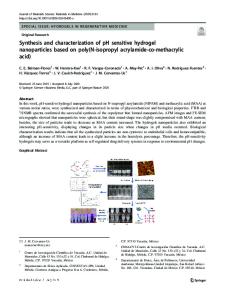Synthesis and Properties of Network Paired Polymers Based on Poly( N -vinylpyrrolidone)
- PDF / 912,477 Bytes
- 8 Pages / 612 x 792 pts (letter) Page_size
- 90 Downloads / 341 Views
MER NETWORKS
Synthesis and Properties of Network Paired Polymers Based on Poly(N-vinylpyrrolidone) V. N. Kizhnyaeva,*, F. A. Pokatilova, and E. V. Akamovaa aIrkutsk
State University, Irkutsk, 664003 Russia * e-mail: [email protected]
Received January 13, 2020; revised March 10, 2020; accepted March 30, 2020
Abstract—The reactive mixing of poly(N-vinylpyrrolidone) modified by the introduction of anchor oxirane fragments with polymers of various nature containing N–H unsubstituted tetrazole rings is carried out. Amphiphilic and polyelectrolyte network paired polymers of the conetwork type are obtained which are capable of limited swelling in aqueous media accompanied by the formation of hydrogels sensitive to changes in the pH, ionic strength, and temperature of the environment. DOI: 10.1134/S1560090420040065
INTRODUCTION Hydrogels based on crosslinked polymers combine the properties of solutions (a low content of the polymer component against the background of a high content of immobilized solvent and high diffusion coefficients) and solids (shape retention and relative mechanical strength). This predetermined the widespread use of hydrogel materials in various fields of science, industry, agriculture, and medicine as superabsorbents of water, sorbents of valuable and environmentally hazardous substances, drug carriers, soft and biocompatible materials, and metal-filled nanomaterials [1–6]. Recently, a special interest of researchers has arisen in the so-called smart polymer gels, which can directionally and reversibly change their properties under the influence of external factors, for example, variation in the composition, ionic strength, pH, and temperature of the environment [4, 7–14]. Gel materials exhibiting similar abilities include hydrogels based on amphiphilic and polyelectrolyte crosslinked polymers; among these, a special place is occupied by macromolecular structures, called “amphiphilic conetworks” (amphiphilic block copolymer networks) [15]. They are crosslinked block copolymers, which, depending on the nature of the chain fragments composing them, possess different types of sensitivity to changes in environmental parameters, including pH sensitivity and thermal sensitivity [15–17]. The network structures, which are paired polymers obtained by the reactive mixing of high molecular weight compounds of various nature, can also be classified as conetworks [4, 18–20]. The network paired polymers are formed by the interaction of anchor functional groups (e.g., N–H unsubstituted tetrazole and oxirane heterocycles), which exhibit chemical affinity and are
located randomly in the structure of heterogeneous macromolecules; as a result, their covalent binding occurs [21, 22]. A three-dimensional network obtained in this way can combine chain fragments of polymers, which are most diverse in nature, ionizing and noninogenic, hydrophilic and hydrophobic, and sensitive to various changes in the environment. One of the promising polymer components for creating paired polymers is poly(N-vinylpyrrolidone) (PVP
Data Loading...










